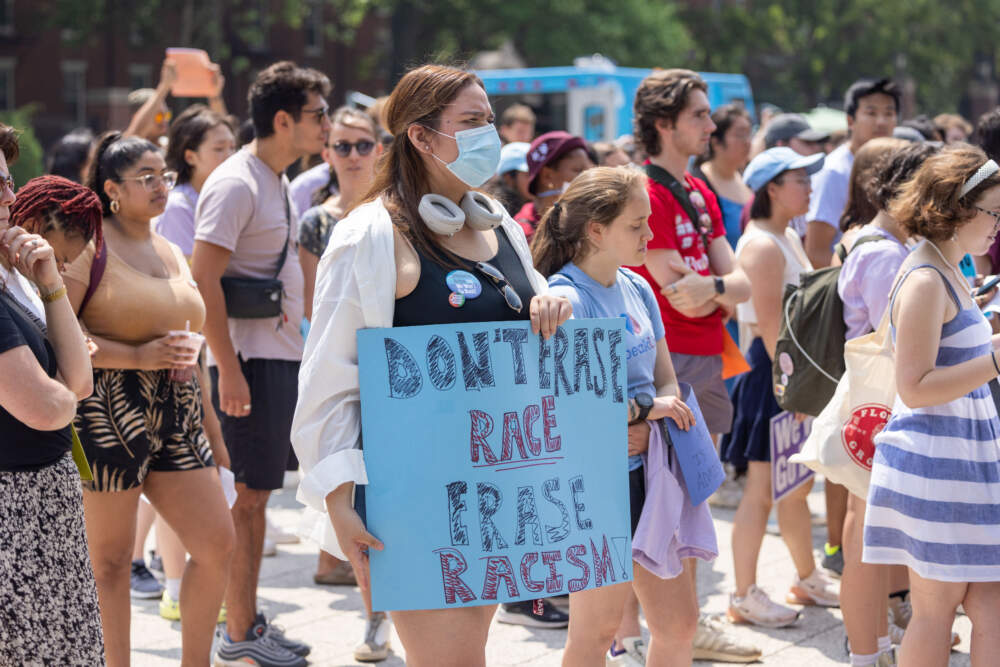Advertisement
Commentary
The surprising win in the Supreme Court’s affirmative action ruling

Although headlines this week roared that the Supreme Court has “banned” affirmative action in college admissions, the 40-page opinion is more nuanced. To be sure, the court imposed new limits on how schools can consider race. But at the same time, the court explicitly endorsed a “holistic” approach to admissions, where admissions officers can consider the many ways in which an applicant’s race may have shaped his or her identity. Opponents of affirmative action who were hoping for a strict colorblind regime didn’t get it.
How to reconcile these two competing strands in the court’s majority opinion? The key difference is between race consciousness on the individual level versus the group level. The former is still allowed. The latter is not — or at least is subject to greater restrictions.
Being conscious of race at the individual level means recognizing that for many people, racial identity is a critical part of who they are. A young Latina, inspired by her heritage, may engage in artistic pursuits linked to her cultural background. A Black high-schooler, drawing on his experiences being racially profiled, may be active in the Black Lives Matter movement. An Asian-American student may be shaped by her experiences as a young child serving as an interpreter for her Chinese-speaking parents.
The Supreme Court has made clear that all of this — and more — can continue to be considered in the admissions process. As Chief Justice John Roberts wrote for the majority: “[N]othing in this opinion should be construed as prohibiting universities from considering an applicant’s discussion of how race affected his or her life, be it through discrimination, inspiration, or otherwise.” In fact, this is the way that most colleges and universities have always considered an applicant’s race: not as a stand-alone factor, but as one of many facets that contribute to an applicant’s identity.
The fact that the court endorsed this consideration of race was by no means a foregone conclusion. Many opponents of affirmative action have long advocated for a strict form of “color blindness” that erases race from an applicant’s life altogether, and had hoped the court would approve that view. The court pointedly refused to go that far.
On the other hand, the majority opinion makes clear that race consciousness at the group level stands on different footing. Harvard, for example, has traditionally kept tabs on the percentages of various racial groups accepted as its admissions process unfolded, to ensure overall diversity in its entering class. As the dissenting justices point out, previous Supreme Court opinions had said that this interest — in assembling a diverse student body — is a compelling one that justifies consideration of race. Previous opinions had spoken eloquently about how diversity in the classroom prepares students for an increasingly multicultural world, allows students from different backgrounds to learn from each other and ensures that pathways to power remain visibly open to all.
Advertisement
But while we decry that backsliding, it’s important to recognize what remains.
After this week’s opinion, however, this form of race consciousness at the group level is on thin ice. The majority did not explicitly overrule its prior cases espousing the importance of diversity in an entering class, which is what has allowed colleges and universities to curate incoming classes with an eye towards overall diversity and a "critical mass" of students of color. Yet the opinion contains enough troubling rhetoric that admissions officers will think twice about monitoring admissions percentages in the way that Harvard has done in the past. This shift is what alarmed the dissenting justices, who criticized the opinion as "stripp[ing] out almost all uses of race in college admissions."
And indeed this change will be challenging for larger schools, where individualized review is a daunting task. The University of California, for example, enrolls over 200,000 undergraduates each fall. When a state initiative banned affirmative action there in 1996, the UC system — unable or unwilling to shift to a holistic admissions process — saw precipitous declines in enrollment of students of color, especially at its flagship schools. But the window that the Supreme Court has now explicitly allowed — to consider race at the individual level — provides an opening for smaller schools, or indeed for larger schools that are up to the task.
For those of us who believe in the critical benefits that flow from diversity in the classroom, the court's retrenchment on affirmative action is discouraging. But while we decry that backsliding, it’s important to recognize what remains. Colleges and universities can still consider an applicant’s race in admissions, so long as that is done at the individual level. That is a critical — and unexpected — win from this week’s opinion. Now it’s up to colleges and universities to make the most of it.
